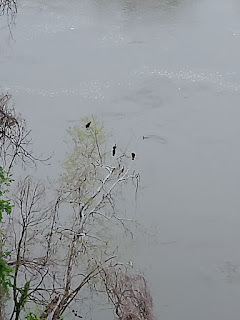Helen Rountree (born 1944) has long been the leading historian of Virginia's Indians. She turned a girlhood obsession with Pocahontas into a successful academic career, writing several books about the people she calls Powhatans. The books she wrote herself cover the period from European contact to the present, and she has also teamed with archaeologists to write two others that take the story back in time.
Before and After Jamestown (2002) is a popular book written at a pretty basic level, but it is full of good information. It is particularly strong on how we know what we know about the Indians of 1607. The sources are: English narratives, especially those of John Smith, William Strachey, and (three generations later) Robert Beverly; archaeology; ethnographic comparison with other Native American communities; and "living history," i.e., modern attempts to re-create past technologies. Rountree makes no use of supposed Native "traditions" until a much later period, when she refers to oral histories recorded in the late 1800s to reconstruct the movements of tribal communities in the reservation era. Rountree is a fan of the English narratives, and while she thinks they misunderstood much, she generally defers to specific claims they made.
For example, John Smith tells us that Powhatan (the person) received the English seated among a dozen of his wives, who were all decked out in their finery. Historians of a feminist bent have challenged this, asserting that the women Smith saw must really have been the Women's Council. But none of our sources mention that Virginia Indians ever had women's councils on the Iroquois model, and even among the Iroquois women's councils had nothing to do with receiving foreign ambassadors, which was entirely managed by the men. Rountree follows Smith's version.
When it comes to archaeology, Rountree is also – how to put this? – pro Eurocentric scholarship. She makes much use of evidence that comes from excavating human burials, including demographic data and chemical analysis that can document diets and movement between regions. Some modern Indians regard information gleaned from looting graves the way others see the work of Nazi scientists, and think it should never be cited. Virginia's Indian communities have until recently been officially on board with Rountree's approach, and have insisted only on reburial of remains after study. One of the biggest Indian events in Virginia in my lifetime was the reburial of the skeletons from the Great Neck Site in Virginia Beach. I think this probably stems in part from the struggles Virginia's Indians have gone through to establish their identity as Indians, which has made them value historical information over purity. I have the sense, though, that this is changing, and younger generations of Native leaders will try to block any excavation of Indian graves.

Rountree participated for decades in living history programs, introducing generations of her students to Indian basketry, ceramics, house-building, and so on. Some participants in these programs have gotten good enough at the tasks involved to give us real data on how long things like weaving reed mats or stitching shell beads to deerskin actually took. The answer is always some version of "a long time." Certain moderns like to fantasize that more primitive peoples lived laid-back, lazy lives, but this was not true of North American Indians. At least two Indian men are recorded as bragging that they were at home wherever they went, since their houses could be put up in a few hours. But that few hours only covers the
assembly of the house. The preparation of the materials could take months, especially in areas where the roofing was reed mats. One of John Smith's famous observations was that forests around Indian villages had been completely stripped of small trees and downed branches, so you could gallop a horse through them unhindered. That was done by women collecting firewood, and it means that after a village had been in place for a few years the women had to travel miles to find fuel for the fires they kept constantly burning.
Rountree has a good eye for issues that are interesting in both the scholarly and general senses. She devotes quite a few pages in Before and After Jamestown to the great difference between men's and women's lives. She has the same impression I have, that certain Indians considered men and women to be separate species that had to come together to make babies but otherwise avoided each other. We have descriptions of Indian women treating their husbands as little more than sources of meat and hides, and mocking or even divorcing them if they failed to provide enough. As for the men, when they entered adulthood they went through a rite that comes down to us under the name of Huskanaw. This was a verion of the standard Woodland Indian initiation rite, in which adolescent boys were taken into the woods and made to hallucinate through some combination of hunger, thirst, pain, exhaustion, and drugs. In the Powhatan version they were supposed to imagine themselves being reborn and emerging with everything they learned in their childhoods forgotten. They even had to be retaught to eat and drink. It's hard to know how seriously to take that claim, but William Strachey wrote it down, so Rountree and I both believe some Indian told him that. Anyway the newborn young men were supposed to forget all childish things and everything else about the years they spent in the company of their mothers.

Randy Turner's contribution to
Before and After Jamestown uses archaeology to extend the story back to around 900 AD, when Virginia Indians took up growing corn and beans. This section is pretty thin, because, honestly, what archaeology tells us about Indian life is pretty thin. We have the outlines of their houses, quite a lot of their pottery, enough animal bones to confirm what John Smith wrote about their diets, and thousands of stone arrowheads. Virginia has the worst kind of soil (acidic) and climate (alternately wet and dry, cold and hot) for preservation of anything else. We have next to no art, and all of what we do have was preserved by being taken to Britain. (Like the deerskin cloak above, to which hundreds of small shells were stitched; the
Ashmolean calls it Powhatan's Mantle.) We know the Indians made cloaks
covered with feathers, but none survive from this part of the world. We know they made music, but we have none of their instruments.
That leaves us with the burials. From them we learn that Virginia's Indians had a harsh age pyramid, with many people dying young and very few living past 50. We learn that they traded for copper from the Great Lakes region and used it to make ornaments. We learn that they had several different ways of treating the dead, which is honestly one of North American archaeology's more puzzling discoveries. Every Indian a white man ever asked said, "Among my people we treat the dead like this," without any qualifications about different approaches for different kinds of people, but the archaeology shows this was not so.
It is humbling for an archaeologist to consider that there is more information in any one of the three main English accounts of Powhatan life than we have ever been able to learn or could learn by any technology we have or could imagine.
What archaeology can do is push the story very far back in time. So far as we can tell, after AD 900 Indians in eastern North America were living in pretty much the way that Smith and Strachey described. They were also ethnically the same people, speaking similar languages. Which is why Turner and Rountree started their book at that time. Rountree in particular has been a great advocate for Virginia's Indians, which had led to her being made an honorary member of two tribes, which I think is yet another reason why she chose this framework of dates.
Because so far as archaeologists can tell, the cultures that formed across the eastern seaboard when Central American agriculture arrived – the triad of corns, beans, and squash – were not ancient. Before that Indians practiced a limited sort of agriculture with native North American plants such as sumpweed and sunflowers, but without corn their lives seem to have been quite different. Tracing the story back 10,000 years we can see people living as hunters and gatherers with low population densities, a world Powhatan people would have found very strange.
Linguistics also tells a story. The Powhatans spoke Algonquian languages that anthropologists are pretty certain came from the Great Lakes region within the past 2,000 years. The archaeology points to c. 500-700 AD as the most likely time. And this is, after the issues of burials, the place where scholars and Indians have lately come into the most stubborn conflicts. After having been shoved out of one place after another, many Indians have taken to insisting that their peoples have lived in their current homelands "forever." For eastern North America, this is not true. Archaeology tells a story of repeated migrations and replacements going back thousands of years. As in Europe and Asia, the spread of agriculture seems to have been accompanied by large scale migrations and conflicts. Of course that never means total replacement, and the Indians who lived in Virginia presumably had some genes from people who had lived in the region 5,000 years ago. But archaeologists don't do "forever."
By starting in AD 900 Turner and Rountree avoided all this controversy. Which is fine, their book is about the Powhatan people, who can't really be said to have existed before then. As I said, as a book about the ethnography and history Virginia's Indians it is very fine. It is also highly accessible, even for students, which is a real achievement. So if you are curious about that time and place I recommend it. I wonder, though, if the historical consensus represented by this book can long endure, or if it exists even in the 2020s. The agendas of Indian activists and people who want to science the past have lately been moving ever farther apart, and I expect that will continue.












_1.JPG)















































